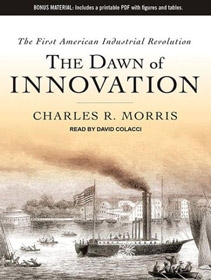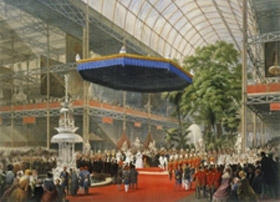We often attribute the spark of America’s economic engines to the second half of the 20th century. Prodigious inventions and discoveries resulted from the post–World War II economic boon and fears of second-class world status in technology after the Soviet Union’s successful Sputnik launch. We are still benefiting from the innovation which poured from the corporate research laboratories of America’s blue-chip companies and the fast-growing populations of America’s research universities.

However, author Charles Morris expertly illustrates how the tradition of innovation in America began just as the new country was getting started. Morris’ recent book, The Dawn of Innovation, describes the transformation of a young nation from a minor player on the world stage at the opening of the 19th century to eclipsing the British Empire at the end of the century as the world’s largest economy and manufacturer. Some of the more famous inventions marking America’s developing industrialization include Robert Fulton’s steamboat (1777), Eli Whitney’s cotton gin (1793), and Samuel Colt’s systemized manufacture of firearms with interchangeable parts (1836).
Morris, a distinguished banker and lawyer by trade, has authored more than a dozen books on American history, with an emphasis on events and personalities that had a profound influence on America’s economic development. With the subtitle, “The First American Industrial Revolution,” his newest book provides an engaging account of the remarkable technologies, businesses, and distribution systems that were put in place across the American continent as settlements rapidly moved west by foot, wagon, boat, and rail.

Some key numbers tell the story. In 1800, Britain was the leading global provider of raw materials, such as coal and iron, as well as finished products, with America’s output a mere one-sixth of that of the British territories. At the 1851 Great Exhibition of the Works of Industry of all Nations, held in London’s Crystal Palace, Victorian England continued to celebrate its mastery of the world’s economy—but the United States gained attention for its ability to mass produce interchangeable parts. Moreover, we were catching up; US production had grown to approximately 30% of the British output. In the 1880s, US output had achieved parity, and by the breakout of World War I, it exceeded British output by a factor of 2.3.
This catch-up century began with war preparations, a familiar boost to economic development. Morris describes the naval arms race during the War of 1812 (1812–1815), in preparation for a major battle between the United States and Britain in the Great Lakes region. Because of its strategic location separating the US and Canada, both sides anticipated major military engagements on Lake Ontario or Lake Erie. In 1812, the US Navy had one ship supporting 16 guns and the British had six ships supporting 40 guns. By the end of this short war, their firepower was essentially equal, and more than 100 ships were armed and manned on each side of the lakes. Fortunately for the sailors in both fleets, there was never a major battle. (Note the uncanny similarity to the Cold War arms race between the United States and the Soviet Union that thankfully never culminated in attack.) The central reason that a significant battle never came to pass appears to be an asymmetry in the fleets’ capabilities. The British were superior in sailing and maneuvering in stormy seas. The American fleet performed best in calm seas and it had amassed a larger quantity of long-range canons, which favored longer distance engagements. This disparity meant that no time was optimal for a good fight. The investment nevertheless proved profitable for America; the necessity to rapidly build up its fleet jump-started the shipbuilding and attendant industries, such as lumber and iron.
Morris traces American industrial development in the 19th century through multiple pathways. Power generation sprang up on almost every stream east and west of the Appalachians. Water turbines were developed for major dams, which are still in use today for generating hydroelectric power. Shipping and transportation networks replaced horse and carriage with canals and steam ships. A rail system crisscrossed the nation by midcentury and quickly grew to an established railroad network, which is also still used today.
At the dawn of the 19th century, the United States was primarily a supplier of raw materials to Britain and the continent; it had to import most finished products. However, US industry quickly evolved beyond agriculture to basic household necessities such as clothing, furnishings, chemical products derived from agriculture (lard and whale oil), and then to the heavy industries that fueled (oil) and transported (steam engines, locomotives) the nation, eventually propelling the US economy to surpass Britain’s. Along the way, a banking industry was established with an elite financier class, with the likes of Mr. Rockefeller, Carnegie, Morgan, and Vanderbilt, who reaped extraordinary fortunes from this exploding economy.
Much of the early development of these technologies and the underlying inventions, such as the steam engine and the Bessemer furnace for steel, were British born. What fed the American economy to grow so rapidly and overtake the mother country? Morris identifies three major factors at the beginning of the century that led to America’s success: 1) near universal male suffrage for the predominant citizenry, leading to widespread participation in local and national government; 2) mass public education, fostering the growth of a significant middle class participating in the economy; and 3) a seemingly unlimited availability of natural resources from an untapped continent. Later, in the midst of the country’s most trying period, the Civil War, President Lincoln’s fractious Congress passed three pieces of legislation in 1862 that strongly underpinned the country’s continued economic growth and prosperity as the war ended: the Homestead Act, the Transcontinental Railroad Act, and the Land Grant College Act. Few pieces of federal legislation before or since have had more effect on the American economy, with the exception of the “GI Bill” after World War II.
Morris completes his account of this first century of American innovation with what he characterizes as a prologue and epilogue. For the prologue, he recounts how the new American nation could reinvent the industrial revolution and out play Britain to become the world’s economic tour de force. In his epilogue he contrasts this history with the current landscape, where the United States has taken the role of incumbent, facing a fast-growing China for 21st-century dominance. There are lessons unfolding on both sides of this economic race; we must consider the values of participatory democracy, a strong public education system, and respect for natural resources. And in this century, we must find a balance between economic power and global welfare.
